Appropriate Post, Crown Selection to Achieve Natural-Looking Esthetics
Robert G. Ritter, DMD
Function and esthetics are the guiding principles in ensuring long-lasting restorations, clinical success, and satisfaction from the perspective of both the clinician and the patient. It is our responsibility and challenge to apply our clinical skills and knowledge to recommend the appropriate treatment and use the best products and techniques to achieve the desired clinical and esthetic results. In the following case, a fiber post paired with an all-ceramic restoration was selected as the preferred choice to replace a discolored maxillary anterior tooth. This technique, selected because of the patient’s history of endodontic procedures—including a root canal and two apicoectomies—allowed the post to be replaced without upsetting the root or the root canal itself.
Often, obtaining natural-looking restorations is a careful balancing act. Use of an opaque understructure may help conceal any dark underlying materials, such as posts or roots, from showing through, while too much opacity can make the restoration appear dull and lifeless. The completed procedure fulfilled the goal desired by the patient—a natural-looking restoration to allow continuity of high-quality esthetics in the anterior dentition.
CASE PRESENTATION
A 56-year-old woman presented with an uneven smile and a discolored front tooth. During the comprehensive examination, the patient explained that her daughter would be getting married in about 6 months and she wanted to improve her smile before the wedding. To create a more esthetically pleasing smile line, the patient was referred to a periodontist for periodontal evaluation. After meeting with the periodontist, the patient agreed to a crown-lengthening procedure for eight anterior teeth (teeth Nos. 5 through 12).
After crown lengthening was completed, the patient was allowed to heal. She returned to the office 4 months later for evaluation of discolored tooth No. 8. The old crown was sectioned off to reveal a large metal post (Figure 1). The metal post was then removed by touching it with a high-speed handpiece two to three times, and twisting it out using a hemostat. The patient expressed great satisfaction on the day of post removal because it was “easy and painless.”
After the metal post was removed, the corresponding drill for the selected size 3 (1.9 mm diameter) RelyX™ (3M ESPE, St. Paul, MN) Fiber Post was used to remove excess cement, clean, and shape the canal (Figure 2). Conveniently, the drill bits are color-coded to correspond with the colored band on each of the RelyX fiber posts, ensuring that the appropriate-sized equipment is used. After completing a try-in of the fiber post to confirm the fit (Figure 3), the RelyX Unicem Aplicap™ Elongation Tip (3M ESPE) was used to backfill a translucent shade of RelyX Unicem Cement (3M ESPE) into the canal space (Figure 4). The fiber post was placed into the canal (Figure 5) and light-cured. Filtek™ Supreme Plus Universal Restorative by 3M ESPE (Figure 6), was subsequently placed on the post followed by final preparation of the crown build-up (Figure 7). A provisional crown was fabricated and seated (Figure 8). The patient’s reaction was positive and she was thrilled that the provisional created a more esthetically pleasing smile than the original crown.
CONCLUSION
Metal posts can potentially shine through anterior all-ceramic crowns, compromising the quality of the esthetics;1 for this reason, a fiber post was selected for this case. An additional issue was that the root itself had darkened with time because of multiple invasive procedures of past dentistry. Fiber posts possess many advantages over metal posts, including enhanced esthetics, firm retention in combination with adhesive cementation, and an eliminated risk of corrosion. Cementing a fiber post with RelyX Unicem provides for root reinforcement.2 RelyX fiber posts also exert greater fatigue resistance than other leading fiber posts. The pairing of the fiber post with the all-ceramic crown combined with the ease and efficiency of the procedure made it possible to atraumatically restore the high-quality esthetics of the patient’s smile, as well as the functionality and longevity of the tooth structure.
DISCLOSURE
The author has received product support from 3M ESPE.
References
1. Qualtrough AJ, Mannocci F. Tooth-colored post systems: a review. Oper Dent. 2003;28(1): 86-91.2. Bitter K, Meyer-Lueckel H, Priehn K, et al. Effects of luting agent and thermocycling on bond strengths to root canal dentine. Int Endod J. 2006;39(10):809-818.
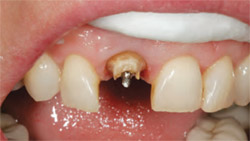 | 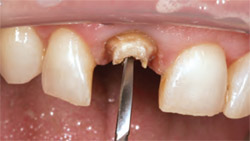 | |
| Figure 1 Preoperative view. The old crown was sectioned off to reveal a large metal post. | Figure 2 After the post was removed, the corresponding drill for size 3 RelyX fiber post was used to clean and shape the canal. | |
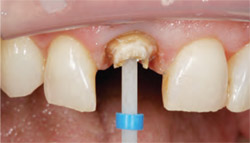 | 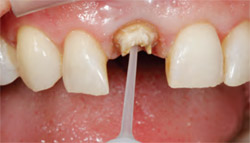 | |
| Figure 3 Try-in of size 3 RelyX fiber post to confirm fit. | Figure 4 Placement of the RelyX Unicem Aplicap Elongation Tip to backfill RelyX Unicem cement into the canal space. | |
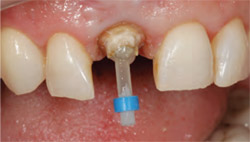 | 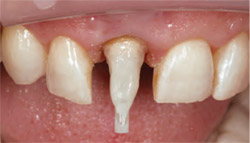 | |
| Figure 5 Placement of post into RelyX Unicem cement in the canal. | Figure 6 Filtek Supreme Plus universal restorative placed on the post. | |
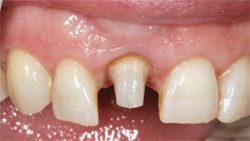 | 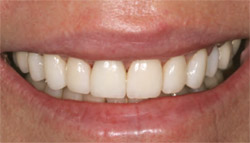 | |
| Figure 7 Final preparation of the tooth. | Figure 8 View of final smile. | |
| About the Author | ||
 Robert G. Ritter, DMD Robert G. Ritter, DMDPrivate Practice Jupiter, Florida | ||



